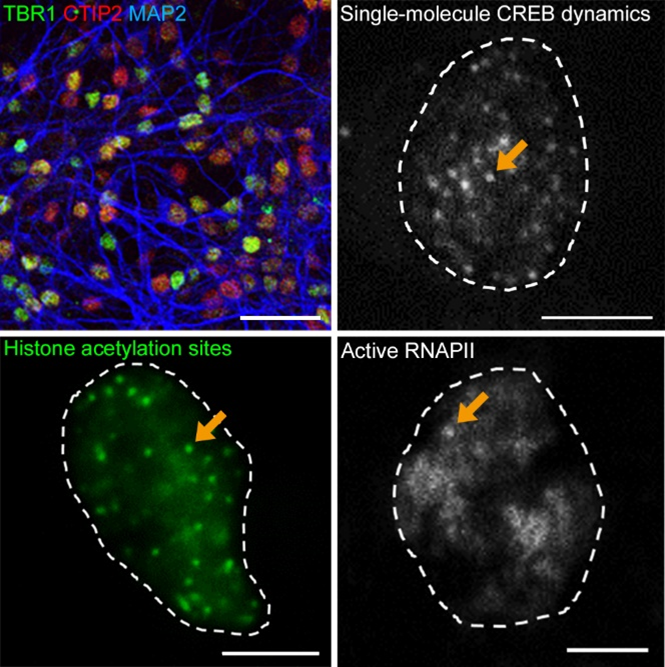The brain requires deep, detailed connections between and among its cells to function properly. Just as no man is an island, neither neuron is either. Recently, Japanese scientists have discovered a basic process that instructs neurons on when and how to create these connections.
 In human ES cell-derived cortical neurons (upper left), single-molecule CREB dynamics were observed (upper right). Activity-dependent repetitive CREB binding to DNA occurred at histone acetylation sites (lower left), where active RNAPII accumulation induces gene expression (lower right). Dashed lines indicate the outline of the nucleus. Scale bars: 50 µm (top left) and 5 µm (others). Image Credit: Yuri Atsumi
In human ES cell-derived cortical neurons (upper left), single-molecule CREB dynamics were observed (upper right). Activity-dependent repetitive CREB binding to DNA occurred at histone acetylation sites (lower left), where active RNAPII accumulation induces gene expression (lower right). Dashed lines indicate the outline of the nucleus. Scale bars: 50 µm (top left) and 5 µm (others). Image Credit: Yuri Atsumi
Researchers from Osaka University and Shenzhen Bay Laboratory have uncovered the actions of proteins connected to memory and learning in human brain cells in a study that was just published in Cell Reports.
The production of genes required for brain cell growth and connection formation is stimulated by neuronal activity in the developing brain. Developmental and psychological issues can occur if this process is disturbed.
The transcription factor cAMP response element binding protein (CREB) is required for the brain to learn and form memories. While CREB and CREB binding protein (CBP) are known to interact to stimulate gene expression in the developing brain, it is unclear how neuronal activity affects this interaction.”
Yuri Atsumi, Study Lead Author, Graduate School of Frontier Biosciences, Osaka University
To investigate this, the researchers tracked the motions of CREB and CBP in human brain cells using a highly developed microscopy method known as single-molecule imaging.
The results were very clear. We found that neuronal activity markedly increased repetitive, long-term interactions between CREB and DNA and between CREB and CBP.”
Noriyuki Sugo, Study Co-Senior Author and Researchers, Osaka University
RNA polymerase II was drawn to these connections and subsequently promotes gene expression. Moreover, the researchers found that previous acetylation mediated by CBP is necessary at the locations where CREB interacts with DNA to increase gene expression.
These findings not only elucidate the mechanism underlying learning and memory in developing brain, but also offer new insight into how psychiatric disorders may develop.”
Nobuhiko Yamamoto, Study Co-Senior Author, Osaka University
Since the CBP gene can result in Rubinstein-Taybi syndrome, a condition marked by intellectual impairment in patients, the development of this disease could be better understood if the CBP protein is rendered inactive. Further investigation of CREB-CBP interactions in three-dimensional brain-like models could give further information on the consequences of the neuronal activity seen in this study.
Source:
Journal reference:
Atsumi, Y., et al. (2023). Repetitive CREB-DNA interactions at gene loci predetermined by CBP induce activity-dependent gene expression in human cortical neurons. Cell Reports. doi.org/10.1016/j.celrep.2023.113576